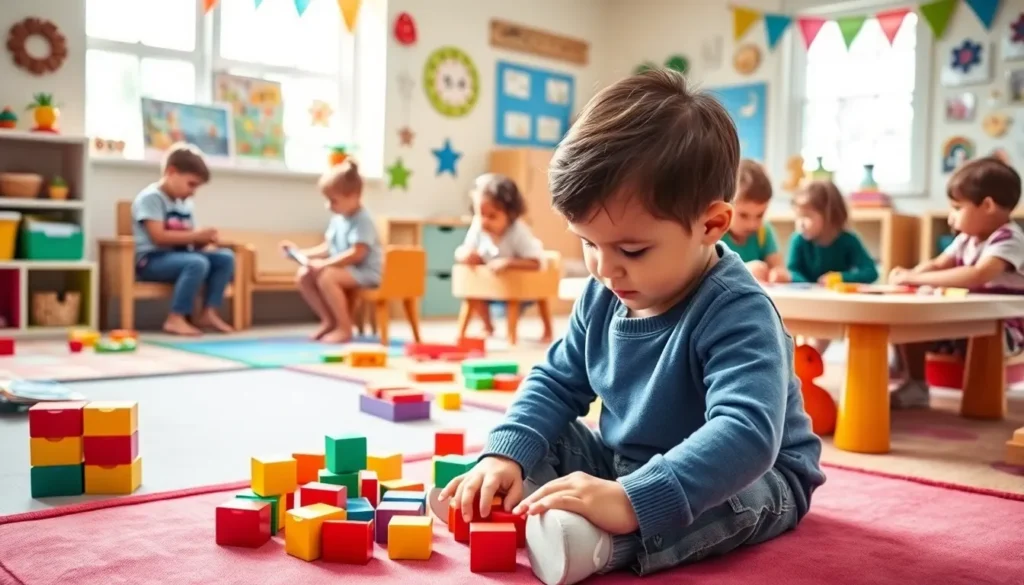Open adoption isn’t just a trend; it’s a heartfelt journey that’s reshaping families and redefining connections. Imagine a world where birth parents and adoptive families join forces, creating a supportive network that benefits everyone involved. Sounds like a win-win, right?
In an open adoption, relationships flourish beyond the traditional boundaries, allowing for communication and shared experiences. It’s like having a family reunion every time you meet up, minus the awkward small talk and questionable potato salad. This approach not only nurtures the child’s sense of identity but also fosters a community of love and understanding. Dive into the world of open adoption and discover how it can transform lives, one joyous connection at a time.
Table of Contents
ToggleUnderstanding Open Adoption
Open adoption fosters meaningful connections among birth parents, adoptive families, and children. This collaborative approach has the potential to transform relationships and enhance a child’s sense of identity.
Definition of Open Adoption
Open adoption refers to an arrangement where birth parents and adoptive families maintain contact. This type of adoption allows for ongoing communication, ensuring that children grow up with knowledge of their biological roots. Birth parents often receive updates about their child’s life, and in some cases, they may participate in visits. Many individuals view this transparency as beneficial, creating a supportive atmosphere for the child. Open adoption not only strengthens family dynamics but also promotes emotional well-being for all involved.
Types of Open Adoption
Several types of open adoption exist, each varying in the level of contact and communication between parties. Full openness includes regular face-to-face meetings, allowing for significant interaction. In a semi-open arrangement, communication may occur through letters or emails, but direct contact is limited. Lastly, a mediated approach involves a third party, such as an adoption agency, facilitating communication. Each type serves different needs, ensuring that birth parents and adoptive families find a comfortable balance that works for them. Understanding these options empowers everyone to make informed choices in their adoption journey.
Benefits of Open Adoption

Open adoption offers numerous advantages for everyone involved. It creates lasting connections, promotes transparency, and supports healthy family dynamics.
For Birth Parents
Birth parents gain comfort and reassurance. They maintain a relationship with their child, allowing them to witness their growth and progress. This ongoing connection can alleviate anxiety about their child’s well-being. Sharing milestones strengthens bonds, fostering a sense of belonging. Birth parents also find empowerment in having a voice in their child’s life and decisions, promoting informed choices.
For Adoptive Parents
Adoptive parents experience increased confidence. They benefit from insights and stories shared by birth parents, which enrich their parenting experience. Understanding the child’s background enables adoptive parents to provide emotionally nurturing environments. Open communication helps build trust with birth parents, allowing for collaborative care decisions. Knowledge of the child’s heritage enhances their support as the child grows.
For Adoptees
Adoptees enjoy a sense of identity and belonging. They access information about their origins, which fosters self-esteem. Relationships with birth parents offer emotional support and guidance. The opportunity to navigate their unique story promotes resiliency while growing up. Additionally, adoptees appreciate having a broader family network, enriching their lives with diverse experiences and perspectives.
Challenges in Open Adoption
Open adoption brings its share of challenges, which can affect all parties involved. Understanding these difficulties helps families navigate their unique journeys.
Emotional Challenges
Emotions can run high in open adoption. Birth parents often grapple with feelings of loss and grief, despite having chosen the arrangement. Adoptive parents may experience anxiety about their role in the child’s life and how they fit into the child’s story. Children might struggle with loyalty issues, feeling torn between their adoptive and birth families. Healthy emotional processing requires open discussions to address these feelings. Regular check-ins and emotional support can ease tensions and promote healing. Families can benefit from counseling services or support groups to help manage these complex emotions effectively.
Communication Barriers
Effective communication plays a crucial role in open adoption, yet barriers often arise. Differences in communication styles can lead to misunderstandings. Birth parents and adoptive families may have different expectations regarding contact frequency or nature. Cultural differences might also affect how each party expresses emotions and needs. To bridge these gaps, establishing clear communication guidelines is essential. Utilizing technology, such as video calls or messaging apps, creates opportunities for regular interactions. Regularly scheduled meetings promote consistent communication, which is vital for maintaining healthy relationships.
Legal Considerations in Open Adoption
Legal aspects of open adoption significantly shape relationships between birth parents and adoptive families. Understanding these considerations ensures everyone involved navigates the process effectively.
Adoption Agreements
Adoption agreements serve as essential documents outlining the expectations for ongoing relationships. These written agreements detail the level of contact between parties, specifying how often and in what manner communication occurs. They promote clarity and prevent misunderstandings, fostering a trusting environment. Specific agreements may include provisions for phone calls, emails, or in-person visits, allowing families to tailor the arrangement to their needs. Legal enforceability varies by jurisdiction, so consulting an attorney specializing in adoption is crucial. This guidance ensures adherence to local laws and protects all parties’ interests.
Custody and Visitation Rights
Custody and visitation rights dictate the nature of parental involvement in a child’s life. Birth parents may retain certain rights even after the adoption finalizes, depending on the agreement’s terms. Adoptive parents typically gain full legal custody, allowing them to make decisions regarding the child’s welfare and upbringing. Nevertheless, open adoption arrangements can allow birth parents visitation rights, promoting ongoing relationships. Courts consider the child’s best interests when determining visitation schedules, which may involve mediation to resolve disputes. Understanding these rights helps families maintain healthy relationships while respecting each party’s roles in the child’s life.
Open adoption represents a transformative approach to family building that nurtures relationships and fosters understanding. By prioritizing communication and collaboration between birth parents and adoptive families, it creates a supportive environment for all involved. This model not only enriches the lives of children but also provides birth and adoptive parents with a sense of reassurance and empowerment.
While challenges exist, such as emotional complexities and communication barriers, the potential for growth and connection is immense. With proper guidance and legal considerations, families can navigate this journey together. Embracing the principles of open adoption can lead to fulfilling relationships that honor every individual’s unique role in a child’s life.




